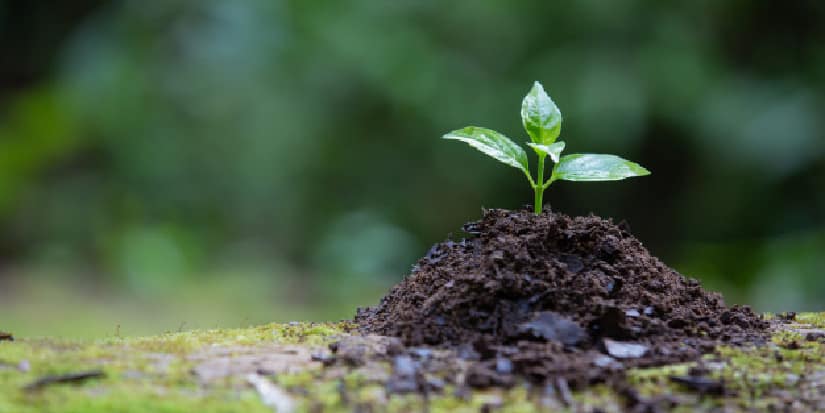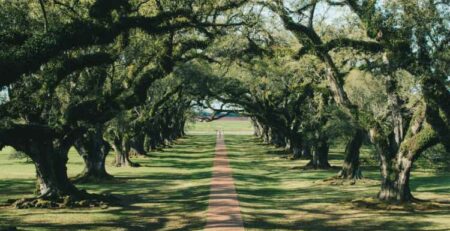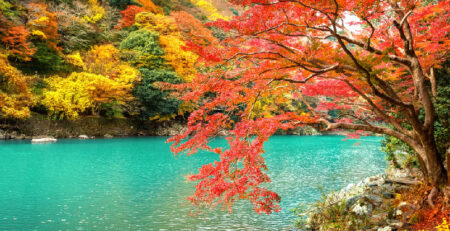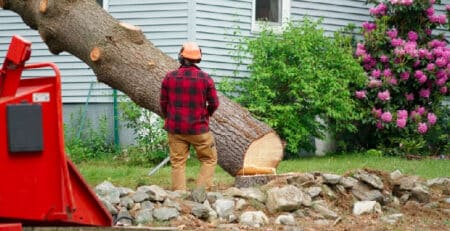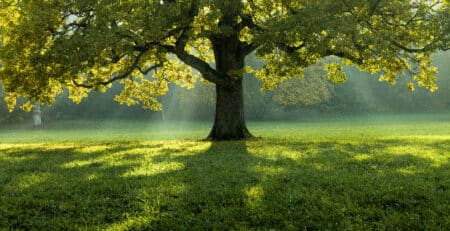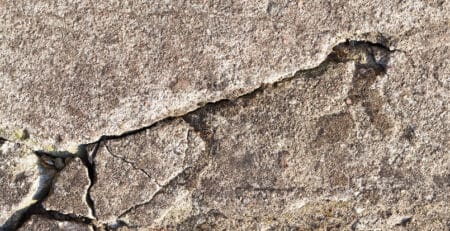Key Differences Between Trees vs Plants
Have you ever wondered what the major differences between trees and plants are? You might not have even realized that they are in the same family due to their size difference. Trees and plants are both members of the Plantae kingdom, but they have unique characteristics. Although there are similarities, trees and plants are very different. Here are 13 essential differences to look out for between trees vs plants.
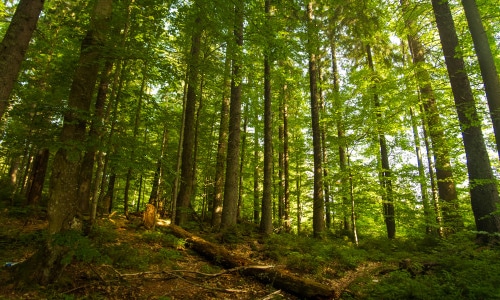 1. All Trees are Plants, But Not All Plants Are Trees
1. All Trees are Plants, But Not All Plants Are Trees
A little-known fact between trees vs plants is by definition, trees are plants because they belong to the Plantae Kingdom. A plant may or may not grow into a tree. All trees are plants, but not all plants are trees. Trees have a unique set of features and traits that separate them from plants. Many of these characteristics are visible, but some are more subtle. Size, life expectancy and composition are among critical factors that distinguish plants from trees. Essentially, trees are plants that continue to grow, developing features that classify them as trees rather than plants.
A tree is a plant with a framework comprised of a trunk and branches to support leaves. It also has a root system to hold the branch in place and secure essential growth elements, such as water and nutrients. One of the key differences between trees and other plants is the ability to live for decades and up to several millennia. The oldest known tree is a baobab in South Africa, which is 6,000 years old. Most trees grow taller than surface vegetation in most parts of the world. Standing at heights above several meters, they can reach a height of about 115.55 meters (the tallest recorded tree is a giant redwood in northern California).
 2. Height and Size
2. Height and Size
One of the most distinctive differences between plants and trees is their size. While plants can grow quickly and expand to cover a significant amount of ground, trees tend to be much larger. Tree canopies can be vast, and the roots beneath the ground can create expansive networks. Typically, plants are smaller and occupy a lot less space than trees. Larger plants are often known as bushes.
It is common for trees, whether they be columnar, pyramid or spreading shapes, to appear in a wide variety of natural forms. They range in size from dwarf trees ranging in height from 10 feet to large trees such as the giant sequoia that stands up to 260 feet tall. Trees are known to be the largest plant in the plant family. As plants generally live closer to the earth, they range from grasses, mosses, shrubs, mats and clumps to grasses, mosses, shrubs, mats, and clusters.
Trees are known for their height, which is one of the most apparent differences between plants and trees. While plants tend to grow no higher than head height, trees can grow to hundreds of metres. According to the Guinness Book of World Records, the world’s tallest tree is a Hyperion redwood located in Redwood National Park, California. It measures a staggering 116 metres. The average height of trees depends heavily on the type of tree. Examples of tall trees include mountain ash, coast douglas fir, giant sequoia, southern blue gum and yellow meranti. Shorter trees include silver birch, magnolia, rowan and hawthorn trees.
The Pacific Northwest is home to tall trees with a long growing season and fertile soil. Several old-growth Douglas fir forests rise 250 feet in the air west of the Cascade Mountains. Pines of the ponderosa variety are just as tall, reaching over 150 feet (Burns and Honkala, 1990). Height is an important ecological characteristic because sunlight competition often determines which trees flourish and which plants die. The shade provided by trees also influences shades in streams, changes in understory vegetation over time, and the cover provided by trees to animals. As such, trees provide an important element of many natural resource data collections.
 3. Tree Trunks vs Plant Stems
3. Tree Trunks vs Plant Stems
One of the most important differences between trees vs plants is the contrast between stems and trunks. The density and composition of stems and trunks differ, but there are additional features to consider. The tree trunk is truly unique. If you were to open up a trunk or use X-ray glasses to peek beneath the surface bark, you would find an intricate network of vessels and tissue. The trunk and roots are like a plumbing system for the tree. The trunk comprises layers, including phloem, cambium and xylem. The phloem sits beneath the outer layer of bark. The cambium is between the phloem and xylem. The xylem and phloem layers play a crucial role in transporting fluids and nutrients, while the cambium produces cells that form new phloem and xylem.
With natural shapes on the rise, the multi-stem is a new trend. In fact, the traditional clear stem tree with its straight trunk and a crown of at least two metres is becoming a bit of a cliche. Nature has trees with branches far lower on their trunks due to animals eating them and being in a light forest. These trees have a single trunk too but have lateral branches from their base upwards. Its bottom is often its widest part. In cultivation, a multi-stem tree is usually trimmed so that separate trunks grow close together. In general, trees with multiple stems tend to have a vase-shaped crown structure: it’s narrower at the bottom and becomes more expansive as it grows up.
A single central trunk characterizes trees. This structure, which tends to be robust, sturdy and statuesque, is a reliable, woody stem responsible for providing stability for the tree. In contrast to the sturdy trunk of the tree, plant stems are softer and more tender. Plants can have a single stem or multiple offshoots.
 The Strength of Stems
The Strength of Stems
Stems, the most structural axes in the composition of plants, have been identified as the primary component that provides the water, nutrition, and adsorption source. They hold up the buds, fruits, and leaves of the plant and provide a nutritional pathway to these parts (which include water, minerals, and sugars). They are often attached to the trunk of the plant, which itself is attached to the auxiliary stems. Photosynthesis is made possible by the stems, which enables the leaves to produce food.
A plant’s stem has three main parts: the xylem, phloem, and cambium. The xylem cells carry the water, while the phloem cells carry food. Without a trunk, the stem will link the roots and leaves.
Other than being essential to plants’ growth, stems help with asexual reproduction. The stems are grafted and cut to produce a new plant, either to breed with another plant species or to be grafted. Besides storage and protection, the stems can also form an element of architectural design, regardless of whether they are above ground or underground. There are many distinct types of stems. Some are woody trunks; others are shoots, branches, or stems of succulent plants.
The trunk of plants is another plant part, but it is found in trees. Located at the center of each tree, their primary support structure is responsible for their survival. Each tree’s trunk links directly to the tree’s trunk while the branches connect with the trunk in reverse order. The trunk is characterized as the tree’s main stem since the tree branches are also known as stems.
Like other plant stems, the trunk also has a protective bark and rings indicating the age when it is cut. Furthermore, the trunk does not have leaves directly attached to it, making it an important lumber member for several applications. Wood from the trunk is used for furniture production and construction. Paper is also made from the trunk.
 4. Annual vs Perennial
4. Annual vs Perennial
Trees are classified as perennial because they have a long lifespan, and they live for several years. In many cases, plants are seasonal, and they may only last a single season. Plants can be annual, biannual or perennial, depending on the species. Perennials survive for a minimum of five years, with many lasting over 100 years. Bi-annual plants will only last two seasons. There is a genetic difference between annual and perennial plants. Annuals live for only one growing season, and then they die, while perennials regrow every year.
Perennials propagate from one generation to the next and one growing season to the next by developing flowers and seeds rapidly. Researchers explained that annual plants grow rapidly following germination and undergo rapid flowering and seed formation, thus preventing energy loss that would otherwise be lost making permanent structures.
A perennial might instead construct “structures” like a bulb, a tuber, or buds that contained undeveloped cells that could be transformed into stalks and leaves when the next growing season began.
Annuals make flowers for many years before they die after producing seeds. The plant’s clock senses the time of day and sunlight and triggers “blooming-induction genes” when it senses the right conditions.
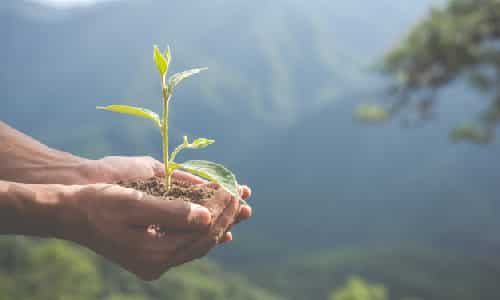 5. Lifespan
5. Lifespan
One of the most intriguing things about trees is their lifespan. When you take a walk in a forest or stumble across a woody clearing on a weekend hike, you may be able to see trees that have lived for decades, maybe even centuries. Trees continue to grow as they age, and they have adopted sophisticated, innovative survival tactics to withstand the elements and protect against predators. It is not unusual for trees to live for over a hundred years. The world’s oldest tree, a spruce, is located in Sweden. Experts believe that this famous tree is around 9,550 years old. In contrast to trees, plants have a short lifespan. Often, plants die due to human activity or conditions that make the environment or conditions unsuitable.
The palm tree has a life expectancy of 50 years. The persimmon tree has an average life expectancy of 60 years, and the black willow tree has a life expectancy of 75 years. Tree rings are visible in trees in temperate climates with distinct seasons. If you drill a hole from the outer bark to the trunk center, rings can be easily counted.
Plants only live as long as they are given exactly what they need from the soil, to light, to the temperature. Due to genetics and other factors, some plants have a much better chance of living well into their senior years.
Contrary to animals, plants grow indefinitely. If conditions are right, they keep growing almost without limits. House plants can grow so large that if untrimmed, they will eventually fail to do their weight, and water won’t reach from their roots to their branches. Imagine this happened to you. You would keep growing as long as you kept eating, growing so tall you couldn’t fit into anything or eat enough to sustain your body.
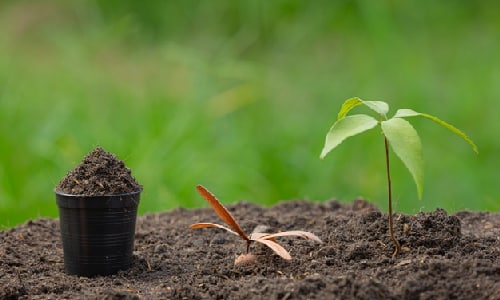 6. Growth Speed
6. Growth Speed
Both plants and trees can grow quickly, provided that they have access to light, water and air, but plants tend to grow faster and reach their maximum height and size long before trees. Plants that continue to grow eventually become trees. Trees develop at different speeds depending on the species. Examples of fast-growing trees include:
- Hybrid poplar
- Weeping willow
- Dawn redwood
- River birch
- October glory red maple
Among plants, bamboo is one of the plants that grow the fastest. Even more remarkable, it can grow more than three feet in one day, assuming ideal conditions. In summer, Alaskan gardens grow so well with 18+ hours of daily sunlight, almost continuously for three months. It’s almost like the plants don’t stop until the end of the summer!
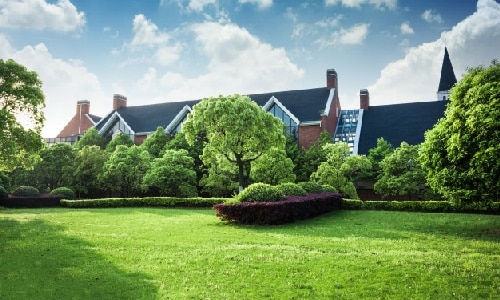 7. Proximity to the Ground
7. Proximity to the Ground
When you look at gardens, parks, meadows and forests, it’s often possible to see clear differences between plant and tree growth. While plants, shrubs and bushes are close to the ground, trees stretch towards the sky. Plants stay close to the soil while trees continue to grow, their long, solid trunks providing stability and support. There are exceptions to the rule, and not all trees are huge and not all plants are small. The species will impact height, as well as the conditions. If a tree doesn’t have access to air, sunlight and water, it won’t grow tall, even if the species is known for its height.
In some cases, trees can be similar to shrubs in height. Trees such as the Japanese Stewartia, Camellia Japonica, and the Black Diamond Crepe Myrtle only grow about ten feet. Many homeowners will look to smaller trees to spruce up their yard. The key is finding trees that won’t engulf your whole yard but add character to it. Here is a great list of some small trees that will do just that.
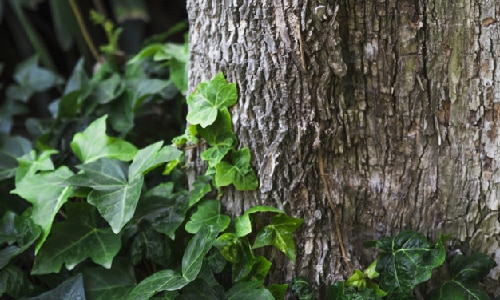 8. Outer Protection
8. Outer Protection
Trees are unique because they have bark. Tree bark is a protective coating, which covers the trunk. This woody tissue comprises mostly dead phloem and cork. Human skin is similar to tree bark in terms of its purpose of defending and protecting the body’s internal structures. Bark provides a barrier, which keeps moisture in at the same time as preventing disease and infection and deterring predators.
In trees, wounds are closed by two separate procedures that result in both chemical and physical barriers around the cells that have been damaged. This process enables the remaining healthy cells to continue to grow and the removed cells to cease decaying, thereby leading to regeneration. Considering all factors, some callus growth follows in time. Eventually, it covers and seals the wound, allowing new, uncontaminated wood to grow over the scar.
In all healthy forests, decay exists on some scale. However, when trees can control wounds to avoid spread, infections are localized and do not spread to adjacent intact, uninfected wood. It is astounding how well this tree injury defence system works, given how common wood rot is in trees, even if they appear healthy. Wounds are covered, and the tree grows around them.
 9. Root Systems
9. Root Systems
Both plants and trees need roots for stability, security, and vital nutrients and moisture from the ground. The key difference between plant and tree roots is the size and scale of the root network. Plant roots are much smaller, narrower, and weaker than tree roots, covering several metres and incredibly strong. Most tree roots are located approximately 50-80cm beneath the ground. The largest, tallest trees can have roots that spread up to 5 metres in diameter.
Besides absorbing and transferring water and minerals, roots also serve to support the tree above ground. There are two types of roots, woody and nonwoody.
Trees with nonwoody roots usually grow in the upper 1-2 inches of soil. Their primary function is to absorb water and nutrients. In addition, some trees’ root hairs are longer than the roots, increasing the nutrient and water uptake rate. The evergreen trees, such as pine, do not have root hairs. Mycorrhizae, however, reside on the roots. They do not hurt the trees and in some species, they are quite beneficial.
A tree’s woody roots are lateral roots that grow near the base. It can also provide water and mineral transportation as well as carbohydrate storage. They act as a framework for a tree’s root system and are radial and horizontal. They extend 4 to 7 times the tree’s drip line, and are perennial and show annual growth rings, which is why many tree roots are eventually exposed.
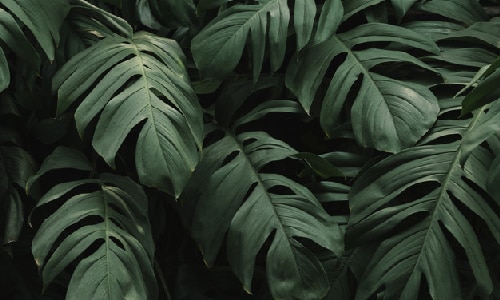 10. Woody Tissue vs Plant Leaves
10. Woody Tissue vs Plant Leaves
Most of us use or buy products made from wood, which originate from trees. Trees are defined by their woody tissue, which forms the trunk. Plants do not produce woody vascular tissue, and their stems are tender. The production of woody tissue provides strength for the tree through a sturdy trunk. The creation of bark is also a defence mechanism. Tree trunks are very useful for humans, and we use them for a range of purposes. For human use, the woody trunk is the primary focus, rather than the leaves, which are of interest when using plants.
In order for leaves to make food, they must utilize sunlight energy. When leaves are exposed to sunlight, they take carbon dioxide from the ground’s air and water. It then uses this mixture to make sugar. This food-making process is called photosynthesis.
Plants get water from inside their trunk through pipes that go down to their roots. The roots pull water from the soil and use it. There are also chemicals in the water that help the plants stay healthy, just like vitamins for people. It freezes in winter, so it is hard for water to get into the soil. Plant roots can’t get the same amount of moisture as they can in warm seasons.
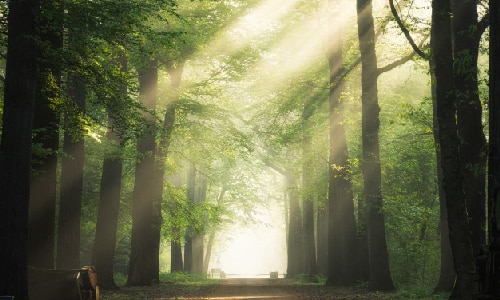 11. Practical Use
11. Practical Use
Human beings have very different uses for trees vs plants. Trees are diverse species, and they offer us a wealth of opportunities. We use trees to make all kinds of products and items. From furniture and paper to producing fuel for keeping warm and using wood to build and construct shelters and houses, trees are incredibly precious. Plants are also very useful. Many people use plants for decorative purposes to create stunning gardens and add vibrancy to indoor spaces, but they have additional uses. Researchers, manufacturers, chefs and scientists use plants to create medicines and remedies and produce food and drinks.
As well as their practical uses and applications, trees vs plants can also influence our moods and how we feel. Studies suggest that being around trees and plants can have a positive impact on health and wellbeing. Research shows that people who have plants in their offices and workplaces are more productive, while spending time in the great outdoors can lift your mood and lower stress levels.
Summary of Differences Between Trees vs Plants
There are many similarities between trees vs plants, but crucially, there are also significant differences. Trees and plants belong to the Plantae kingdom, meaning that trees are a plant type that grows and develops woody tissue. The most noticeable visible difference between plants and trees is the average size. Trees are generally much taller and more expansive than plants, they have deeper, stronger roots, and they grow far from the ground. The woody trunk, which anchors the tree, is a stark contrast to the plants’ fleshy, tender stems. The outer coating of bark acts as a protective barrier against the elements and animals. Another critical difference is the lifespan. Trees often live for hundreds, even thousands of years, while some plants will only last a single season. Each is greatly important to our ecosystem and all of our furry friends that live within it. For many critters and bugs, a tree is a place to call home.

